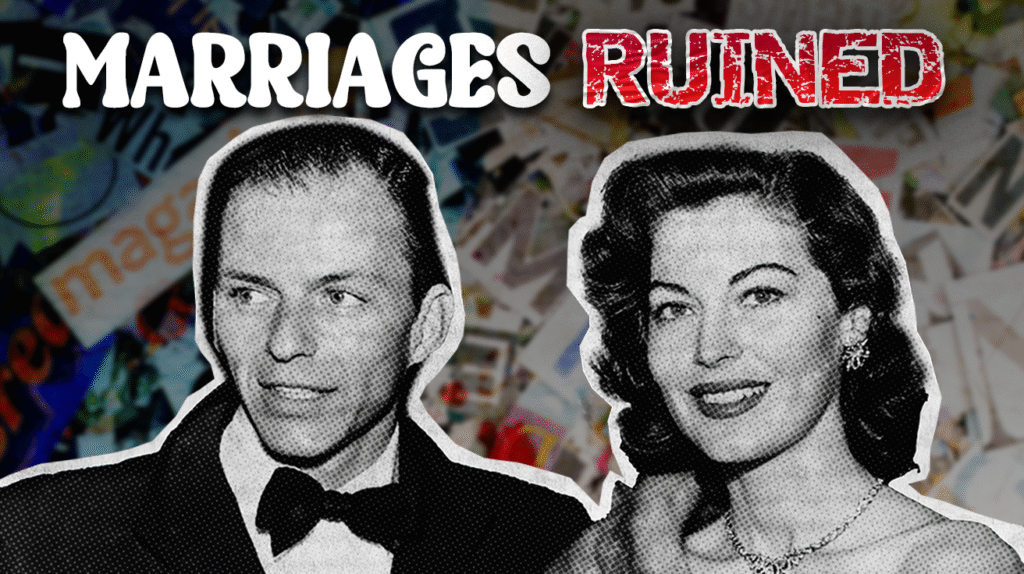
Hollywood’s Golden Age was more than glamour and dreams. It was a high-stakes casino where reputations were gambled nightly and careers could vanish with a whispered rumor. The public demanded perfection while studio executives engineered cover-ups that would make Pentagon officials blush. These weren’t simple affairs—they were career-defining catastrophes that reshaped the entertainment landscape.
What follows is a chronicle of how power operated when cameras weren’t rolling. The pattern repeats with alarming consistency: public adoration weaponized against the very stars who created it. Behind every tearful public apology and studio-mandated ‘rehabilitation’ lurked the only motivation Hollywood executives truly understood: profit margins.
17. Elizabeth Taylor and Eddie Fisher

When America needed a villain in 1958, the Taylor-Fisher affair delivered the perfect morality tale for a gossip-hungry public. After Taylor’s husband Mike Todd died in a plane crash, Fisher—who was married to America’s sweetheart Debbie Reynolds—became close to the grieving widow. The affair broke like a leak in the Hoover Dam, with newspapers practically printing money covering the scandal.
Their May 1959 marriage lasted five years before divorce in 1964, not three years as often reported. The real story wasn’t the relationship itself but how it transformed celebrity coverage forever. Before Taylor-Fisher-Reynolds, stars controlled their narratives. After? The tabloid industrial complex was born. When today’s celebrities complain about paparazzi, they should thank Taylor and Fisher for creating the blueprint their publicists now navigate every crisis with.
16. Ingrid Bergman and Roberto Rossellini

A single pregnancy in 1950 triggered a Congressional denunciation and ended Ingrid Bergman’s American career for half a decade. In 1949, Bergman—the “Casablanca” sweetheart—contacted Italian director Rossellini professionally. By February 1950, she’d given birth to their son while still legally married to someone else.
A sitting U.S. Senator denounced her on the Senate floor on July 25, 1950—cancel culture with government letterhead. Her five-year Hollywood exile only ended with her 1956 Oscar win, proving what industry insiders know: morality is just a temporary obstacle when money’s at stake. Bergman’s journey from pariah to Oscar winner proved what Hollywood insiders already knew: career resurrection requires only one ingredient—commercial viability. Redemption through box-office appeal still echoes in modern underrated movies, where audience passion can resurrect even the most tarnished reputations.
15. Clark Gable and Loretta Young

Caught between career suicide and abandoning her child, Loretta Young engineered Hollywood’s most elaborate deception by adopting her own secret daughter. Her 1935 on-set romance with Clark Gable during “Call of the Wild” resulted in a daughter, Judy Lewis. Young’s “solution” reads like a script too bizarre for fiction: she disappeared, gave birth secretly, then “adopted” her own biological child.
This deception held for nearly 60 years until Lewis published her memoir in 1994. It’s the entertainment industry’s equivalent of Area 51—a secret maintained through intimidation, money, and institutional power. Studios weren’t making movies alone; they were manufacturing reality itself. While modern stars battle social media leaks, Young’s six-decade secret demonstrates how studio control once successfully manufactured reality itself—a power today’s publicists can only dream about.
14. Humphrey Bogart and Lauren Bacall

While fabricated romances filled gossip columns, Bogart and Bacall’s authentic connection offered a rare glimpse of truth in an industry built on illusion. Their meeting on 1944’s “To Have and Have Not” blossomed despite Bogart’s troubled marriage to Mayo Methot. Unlike most industry romances engineered for publicity, theirs contained something increasingly rare in Hollywood: authenticity.
After Bogart’s 1945 divorce, they married on May 21, 1945, and remained together until his death on January 14, 1957. Their partnership reflects what rarely surfaces in industry relationships—emotional substance behind the marketable image. If you’re searching for the rare Hollywood romance not scripted by publicity departments, their partnership stands as the exception that proved how artificial the rule truly was.
13. Spencer Tracy and Katharine Hepburn

If you’re searching for Hollywood’s best-kept open secret, look no further than Tracy and Hepburn’s 26-year relationship that everyone knew about but nobody officially acknowledged. Beginning in 1941 on “Woman of the Year,” their partnership continued while Tracy remained married to Louise Treadwell, unwilling to divorce due to Catholic beliefs.
Hepburn’s sacrifice of five prime career years caring for Tracy before his 1967 death reveals what media accounts consistently missed. This was more than an affair—it was a private commitment more substantial than many public marriages. Their quarter-century commitment outlasted dozens of studio-arranged marriages, proving that Hollywood’s most authentic relationship was the one it couldn’t officially acknowledge.
12. Lana Turner and Lex Barker

Beneath Lana Turner’s glamorous image lurked a family nightmare that even Hollywood’s most powerful damage control teams couldn’t contain. In 1957, Turner’s daughter Cheryl Crane accused stepfather Barker of abuse beginning around age 12, according to Crane’s 1988 memoir “Detour,” not age 10 as often reported. Some secrets were too dark even for Hollywood’s cleanup crews.
The situation spiraled when 14-year-old Crane stabbed Turner’s boyfriend Johnny Stompanato on April 4, 1958. This was the entertainment industry’s equivalent of Chernobyl—a catastrophic failure that exposed the radioactive reality beneath the carefully managed surface. This catastrophic scandal exposed the limits of studio damage control, demonstrating how quickly the machinery of protection collapsed when confronted with crimes too severe for even Hollywood to normalize.
11. Joan Crawford and Clark Gable

Joan Crawford and Clark Gable’s rumored affair operated with military-grade secrecy, proving that Hollywood’s real expertise wasn’t filmmaking but narrative control. While they did work together on 1931’s “Dance, Fools, Dance,” most historians date their relationship to the mid-1930s through early 1940s, not the full two decades often claimed. This wasn’t just a fling; it was part of Hollywood’s shadow narratives running parallel to official publicity.
Their ability to maintain this connection despite Hollywood’s fishbowl environment demonstrates that entertainment industry’s real expertise is creating and protecting narratives. Their affair solved Hollywood’s central paradox: how to maintain public images worth millions while pursuing private lives that would potentially undermine those very images.
10. Ava Gardner and Frank Sinatra

When two of entertainment’s most volatile personalities collided in marriage, the resulting emotional hurricane transformed both their careers. Their relationship began while Sinatra was still married to Nancy Barbato (they divorced in 1951). Sinatra and Gardner married on November 7, 1951, showing all the restraint of a TikTok challenge gone viral. Their subsequent marriage burned through exactly six years before their October 1957 divorce.
Their volatility resulted in professional transformation. Sinatra channeled their emotional wreckage into his music, essentially turning private pain into a commercial product. Their relationship map reads like directions to a train wreck, but that wreckage produced some of the most emotionally authentic work in either of their careers. When Sinatra crooned about lost love after their split, listeners weren’t just hearing a performance—they were witnessing the commercial packaging of authentic emotional devastation..
9. Errol Flynn and Beverly Aadland

While today’s predators face immediate consequences, Flynn’s relationship with 15-year-old Aadland reveals how Hollywood once shielded powerful men from accountability. Beginning in 1957 when Flynn was pushing 50 and Aadland merely 15 (born July 16, 1942), this wasn’t a “May-December romance”—it was predation with a publicity team. The industry’s response? Strategic silence.
The scandal only fully broke after Flynn’s 1959 death, when the machinery protecting him powdered down. This pattern repeats with disturbing regularity throughout entertainment history: power insulates the powerful, not their victims. Flynn’s protected predation reveals Hollywood’s darkest truth: star power purchased immunity from consequences that would have destroyed ordinary men.
8. Rita Hayworth and Ali Khan

Hayworth’s marriage to Aly Khan (international royalty) promised fairy-tale glamour but delivered a cross-cultural collision course that shattered her carefully crafted image. Hollywood royalty met actual royalty in what looked like a fairy tale but functioned more like a merger acquisition gone wrong. Their union, which began November 27, 1949, collapsed within exactly three and a half years before their June 1953 divorce.
Their custody battle over daughter Princess Yasmin exposed the fundamental incompatibility of their worlds. Hayworth’s carefully constructed glamour image shattered against the reality of international politics and cultural expectations. If you’ve ever wondered why film stars rarely maintain relationships with royalty, Hayworth’s spectacular crash landing demonstrates how differently power operates in worlds separated by more than geography.
7. Gloria Swanson and Joseph P. Kennedy Sr.

Power imbalances don’t come more stark than Kennedy simultaneously managing Swanson’s career and bedroom in Hollywood’s ultimate conflict of interest. Kennedy served simultaneously as Swanson’s business manager and lover in the late 1920s, blurring professional and personal lines with the ethical clarity of a mud puddle.
Their bitter 1930 breakup left Kennedy essentially unscathed while Swanson’s career trajectory shifted—the entertainment industry version of too-big-to-fail protection. The power imbalance wasn’t accidental; it was foundational. Kennedy’s seamless exit from their relationship showcase how men with political ambitions could use Hollywood relationships as stepping stones while women stars found themselves more permanently affected by the same connections.
6. Judy Garland and David Rose Then Vincente Minnelli

If you think toxic workplace cultures are a modern problem, Garland’s failed marriages expose how studio control destroyed stars’ personal lives while audiences remained oblivious. At 19, she wed composer David Rose in 1941, seeking stability while MGM executives monitored her weight and prescribed amphetamines like vitamins, as documented in multiple Garland biographies. This marriage collapsed within three years under studio pressure that would violate every HR policy in existence today.
Her 1945 marriage to director Vincente Minnelli produced daughter Liza but ended by 1951, continuing a pattern where Garland’s personal relationships crumbled under the same industry forces that consumed her health. She was an industrial product—manufactured, packaged, and ultimately discarded when production costs outweighed market value. When audiences wept at Garland singing ‘Over the Rainbow,’ few realized they were witnessing a woman whose personal happiness had been sacrificed to the same studio machine that magnified her talent.
5. Marlene Dietrich and John Gilbert

For fallen star John Gilbert, Dietrich’s companionship offered temporary shelter from Hollywood’s most reliable product: systematic obsolescence. Their early 1930s relationship began as Gilbert—once commanding $100,000 per film according to studio ledgers—watched his career implode with the transition to sound. Meanwhile, Dietrich’s star ascended with the momentum of a SpaceX rocket.
Their relationship exists in the shadow region between Hollywood’s public mythology and private reality. While less documented than other affairs, Gilbert and Dietrich’s companionship has been noted by film historians. Their connection offered temporary refuge from Hollywood’s brutal reality: yesterday’s box office king would inevitably become tomorrow’s cautionary tale, with Dietrich merely witnessing the future that awaited her too.
4. Charlie Chaplin and Lita Gray

On October 23, 1924, 35-year-old Chaplin married 16-year-old Gray after she became pregnant—a scenario that today would trigger criminal charges instead of wedding bells. Their catastrophic marriage ended in 1927 with an unprecedented million-dollar settlement (approximately $15 million in today’s dollars).
The public outrage reflected an era before celebrity bulletproofing had been perfected. Chaplin’s reputation took a direct hit, contributing to later persecution for his political views. The scandal demonstrated that even industry titans weren’t completely immune to consequences, though their privilege still provided exceptional insulation. The million-dollar settlement stands as Hollywood’s most expensive marital exit fee of its era and the price tag for temporarily salvaging a reputation worth far more.
3. William Holden and Audrey Hepburn

When core values collided with matters of the heart, Holden and Hepburn’s romance ended not with scandal but with the rarest Hollywood commodity: honest choice. Their connection during 1954’s “Sabrina” wasn’t destroyed by external forces but by fundamental incompatibility: Hepburn wanted children while Holden reportedly didn’t want more after having one child. In an industry built on artifice, their ending came from authenticity.
Their unrealized future hangs over Hollywood history like the road not taken. This wasn’t tabloid material; it was human beings making painful choices based on core values, according to multiple retrospectives and interviews. While other industry relationships imploded from external pressures or power dynamics, theirs ended because of principles—perhaps the rarest commodity in an ecosystem where compromise is the primary currency. Their mutual respect in separation provided something vanishingly rare in Hollywood romance: dignity without tabloid fodder, preserving both careers while many contemporaries self-destructed spectacularly.
2. Bette Davis and Howard Hughes

Davis’s affair with Hughes around 1937 exposed the double standards built into Hollywood’s foundation. Davis and Hughes did meet in 1937, and her husband Harmon Nelson filed for divorce in June 1938. However, contrary to popular narrative, Nelson’s complaint cited “extreme cruelty” and “adultery,” not specifically her career focus. This marked the beginning of institutional scrutiny of Davis’s life choices.
Studio-era divorce filings often contained strategic claims rather than honest grievances. Men’s ambition was celebrated; women’s was penalized. Hughes pursued his business and aviation interests without similar consequences. If you’re searching for the origin of Hollywood’s gender double standards, look no further than the divorce proceedings of its female stars, where different standards applied depending on which gender held the power.
1. Mary Astor and George S. Kaufman

Private words became public spectacle when Astor’s intimate diary transformed a custody hearing into entertainment’s first modern privacy nightmare. Their discreet 1934 affair exploded into public view during Astor’s May 1936 custody battle when her diary became courtroom evidence. The media frenzy that followed makes today’s TMZ coverage look restrained in comparison.
This case demonstrated how quickly privacy collapses when legal proceedings intersect with public curiosity. The diary’s revelations created a feeding frenzy that nearly destroyed Astor’s career. The pattern established then continues today: private behavior becomes public entertainment, repackaged and sold to the same audiences who simultaneously judge and consume it.





















